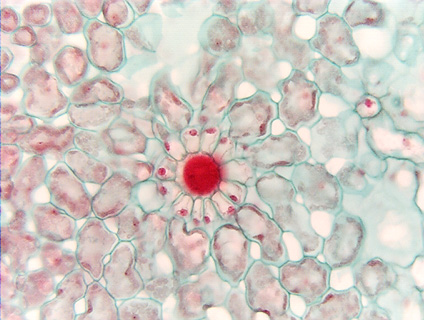 Fig.
10.4-7. Paradermal
section of leaf of ground ivy (Glechoma). This section passes just
through the base of a trichome (the red-stained material is located in the
trichome); the ring
of cells around the red material are epidermis cells that are part of the base
of the trichome itself. Just as stomata may either have subsidiary
cells or lack them, trichomes too may either have special cells around their
base or simply be surrounded by ordinary epidermis cells.
Fig.
10.4-7. Paradermal
section of leaf of ground ivy (Glechoma). This section passes just
through the base of a trichome (the red-stained material is located in the
trichome); the ring
of cells around the red material are epidermis cells that are part of the base
of the trichome itself. Just as stomata may either have subsidiary
cells or lack them, trichomes too may either have special cells around their
base or simply be surrounded by ordinary epidermis cells.